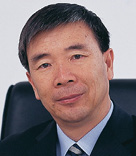The proposal made at the Third Plenum that the “establishment of intellectual property courts be explored” has become a new direction in China’s intellectual property judicial sector. At present Beijing, Shanghai and Shenzhen have applied to the Supreme People’s Court to establish intellectual property courts. The lead author is of the opinion that, in contrast to other legal fields, the legislative and judicial standards in China’s intellectual property sector, as well as the quality of the professionals in the field, have achieved relatively stronger development. Against such a background, the establishment of dedicated intellectual property courts will have a profound and positive effect on the protection of intellectual property in China.

Wang Yadong
润明律师事务所
执行合伙人
Executive Partner
Run Ming Law Office
Adjudication model
The professionalised judicial trial model for intellectual property took shape in China in the 1990s. In 1993, the Beijing Municipal Intermediate and Higher People’s Courts were the first to establish intellectual property divisions, followed by the Supreme People’s Court in 1996. Since then, while the Supreme People’s Court was gradually clarifying the issue of jurisdiction in intellectual property cases, dedicated intellectual property divisions were being established in those courts with case jurisdiction, in the process becoming one of the major reforms in China’s judicial field and effectively enhancing the level of protection accorded intellectual property rights in China.
However, in addition to civil cases, intellectual property cases regularly involve administrative and criminal cases. Before 1995, Chinese courts implemented, in respect of intellectual property cases, an adjudication model in which civil, administrative and criminal cases were tried by three separate divisions – a model that can readily result in divergent findings, or even contradictory findings, over the same facts.
Taking trade secrets cases as an example, criminal adjudication criteria are generally less stringent than civil adjudication criteria, so under the legal principle of “criminal first, then civil”, it is possible for the defendant to be found guilty of the crime of infringing trade secrets in the criminal trial, and then be found not to have committed infringement in the subsequent civil trial.
Accordingly, since 1995, China’s court system has been actively promoting a pilot project for integrating the civil, administrative and criminal in intellectual property cases. As at the end of 2013, more than 160 courts in China were involved in the pilot project for the integrated intellectual property adjudication model.
Although the integrated model has achieved a certain success in practice, intellectual property divisions nevertheless remain divisions established within courts and stand equal to the civil, criminal and administrative divisions. However, intellectual property cases have special requirements in terms of jurisdiction, organisation, management of judicial personnel, etc., which the integrated trial model has difficulty in effectively managing. Furthermore, this trial model also has difficulties in overcoming such practical issues as local protectionism. Accordingly, it has commonly been felt in judicial circles that the establishment of intellectual property courts is the only way to push intellectual property trials in a professional and efficient direction.
The judges
Issues such as the explosive growth in the number of intellectual property cases, the fostering of a contingent of judges, etc., have also dictated that the intellectual property trial regime requires urgent change. Supreme People’s Court figures show that the number of intellectual property cases in China has been climbing at an annual rate of around 30% in recent years, far exceeding growth in other areas. Between 2009 and 2013, the number of civil intellectual property cases at first instance concluded by local courts nationwide increased from more than 30,000 cases to 90,000 cases, and administrative and criminal cases have also shown a large growth trend.

Lu Lei
润明律师事务所
合伙人
Partner
Run Ming Law Office
Additionally, difficult and complex cases involving cutting-edge science and technology issues are continuously increasing. All of these issues pose new challenges to the existing intellectual property adjudication regime.
Furthermore, intellectual property cases involve patent, trademark, copyright, trade secret and other types of cases, each with its own particularities, particularly patent cases, which usually involve extremely technical issues, requiring that judges not only be thoroughly familiar with the relevant legal knowledge but also have a good grasp of specialised knowledge in the relevant field. However, for the great majority of judges who have graduated from law schools without any scientific or engineering education background, this is usually beyond their capabilities.
The establishment of intellectual property courts, while maintaining the stability of the contingent of judges with intellectual property trial capabilities, will also be conducive to the carrying out of research and training, and thereby enhance the specialised adjudication level of judges. It can also promote the necessary awareness of the importance of intellectual property adjudication work in the legal education field and increase the attractiveness of the intellectual property adjudication field to professional talent.
In short, the lead author is of the opinion that the establishment of intellectual property courts is a pressing, yet complex, project that needs to be in harmony with actual national conditions, and in agreement with the existing legal system. This will require managers to comprehensively consider trial instances, scope of jurisdiction and the number of courts when carrying out a top-down design.
Uneven spread of cases
Additionally, the serious imbalance in economic development between regions in China produces a similarly uneven distribution of intellectual property cases, and objectively results in a dearth of experience in trying intellectual property cases, a shortage of qualified judges, etc., in less developed areas, meaning they still do not meet the conditions for the establishment of intellectual property courts.
Accordingly, the lead author is of the opinion that the establishment of intellectual property courts in China needs to take place in an orderly fashion, and there would be no harm in considering designating regions such as Beijing, Shanghai, Shenzhen, etc., where intellectual property adjudication is relatively mature, as pilot regions to be the first to establish intellectual property courts, then progressively expanding from there based on the results of those pilot projects.
Wang Yadong is the executive partner and Lu Lei is a partner at Run Ming Law Office
中国北京市朝阳区建国门外大街甲12号
新华保险大厦1806室
邮编:100022
Suite 1806, NCI Tower
12A Jianguomenwai Avenue
Chaoyang District, Beijing 100022, China
电话 Tel: +8610 65693511
传真 Fax: +8610 65693512/13
www.runminglaw.com
电子信箱 E-mail:
wangyd@runminglaw.com
lul@runminglaw.com






















